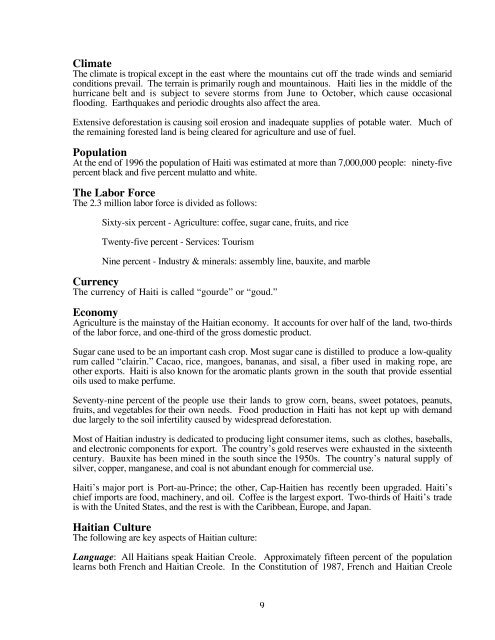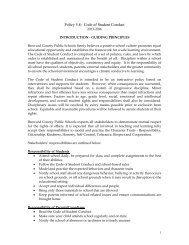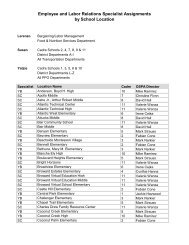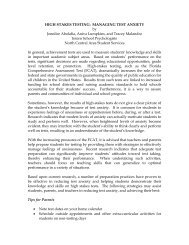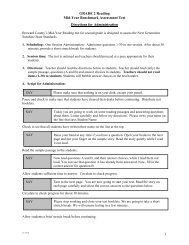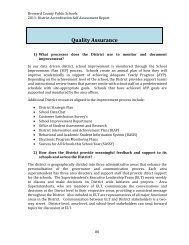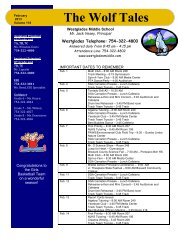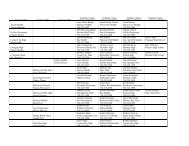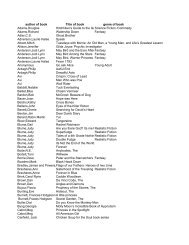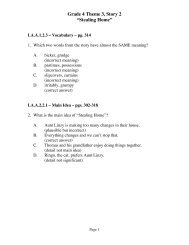Haitian Culture Curriculum Guide
Haitian Culture Curriculum Guide
Haitian Culture Curriculum Guide
Create successful ePaper yourself
Turn your PDF publications into a flip-book with our unique Google optimized e-Paper software.
Climate<br />
The climate is tropical except in the east where the mountains cut off the trade winds and semiarid<br />
conditions prevail. The terrain is primarily rough and mountainous. Haiti lies in the middle of the<br />
hurricane belt and is subject to severe storms from June to October, which cause occasional<br />
flooding. Earthquakes and periodic droughts also affect the area.<br />
Extensive deforestation is causing soil erosion and inadequate supplies of potable water. Much of<br />
the remaining forested land is being cleared for agriculture and use of fuel.<br />
Population<br />
At the end of 1996 the population of Haiti was estimated at more than 7,000,000 people: ninety-five<br />
percent black and five percent mulatto and white.<br />
The Labor Force<br />
The 2.3 million labor force is divided as follows:<br />
Sixty-six percent - Agriculture: coffee, sugar cane, fruits, and rice<br />
Twenty-five percent - Services: Tourism<br />
Nine percent - Industry & minerals: assembly line, bauxite, and marble<br />
Currency<br />
The currency of Haiti is called “gourde” or “goud.”<br />
Economy<br />
Agriculture is the mainstay of the <strong>Haitian</strong> economy. It accounts for over half of the land, two-thirds<br />
of the labor force, and one-third of the gross domestic product.<br />
Sugar cane used to be an important cash crop. Most sugar cane is distilled to produce a low-quality<br />
rum called “clairin.” Cacao, rice, mangoes, bananas, and sisal, a fiber used in making rope, are<br />
other exports. Haiti is also known for the aromatic plants grown in the south that provide essential<br />
oils used to make perfume.<br />
Seventy-nine percent of the people use their lands to grow corn, beans, sweet potatoes, peanuts,<br />
fruits, and vegetables for their own needs. Food production in Haiti has not kept up with demand<br />
due largely to the soil infertility caused by widespread deforestation.<br />
Most of <strong>Haitian</strong> industry is dedicated to producing light consumer items, such as clothes, baseballs,<br />
and electronic components for export. The country’s gold reserves were exhausted in the sixteenth<br />
century. Bauxite has been mined in the south since the 1950s. The country’s natural supply of<br />
silver, copper, manganese, and coal is not abundant enough for commercial use.<br />
Haiti’s major port is Port-au-Prince; the other, Cap-Haitien has recently been upgraded. Haiti’s<br />
chief imports are food, machinery, and oil. Coffee is the largest export. Two-thirds of Haiti’s trade<br />
is with the United States, and the rest is with the Caribbean, Europe, and Japan.<br />
<strong>Haitian</strong> <strong>Culture</strong><br />
The following are key aspects of <strong>Haitian</strong> culture:<br />
Language: All <strong>Haitian</strong>s speak <strong>Haitian</strong> Creole. Approximately fifteen percent of the population<br />
learns both French and <strong>Haitian</strong> Creole. In the Constitution of 1987, French and <strong>Haitian</strong> Creole<br />
9


